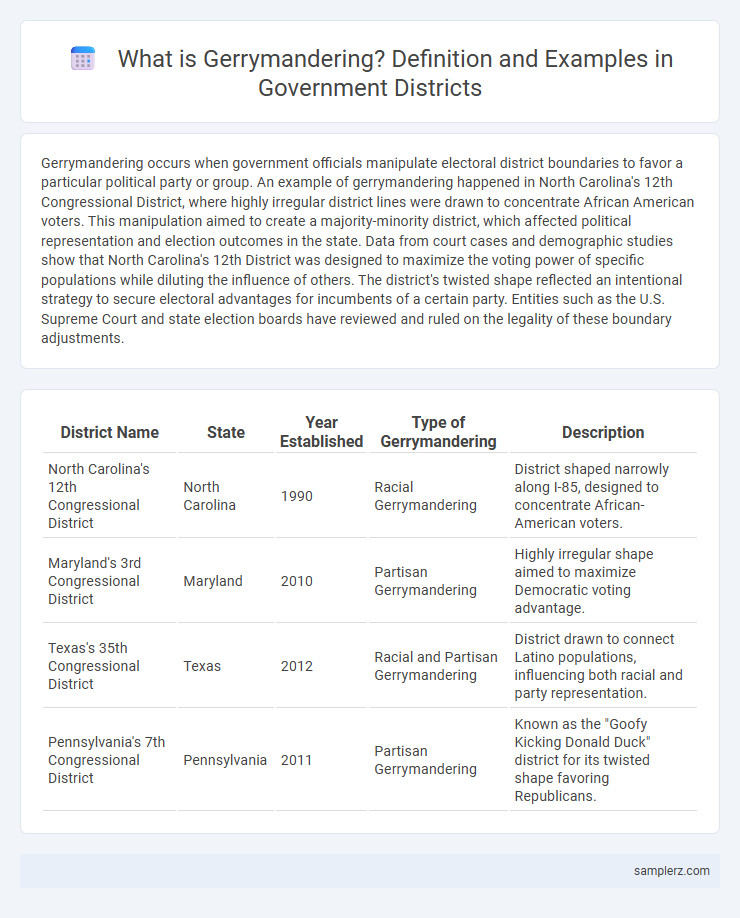Gerrymandering occurs when government officials manipulate electoral district boundaries to favor a particular political party or group. An example of gerrymandering happened in North Carolina's 12th Congressional District, where highly irregular district lines were drawn to concentrate African American voters. This manipulation aimed to create a majority-minority district, which affected political representation and election outcomes in the state. Data from court cases and demographic studies show that North Carolina's 12th District was designed to maximize the voting power of specific populations while diluting the influence of others. The district's twisted shape reflected an intentional strategy to secure electoral advantages for incumbents of a certain party. Entities such as the U.S. Supreme Court and state election boards have reviewed and ruled on the legality of these boundary adjustments.
Table of Comparison
| District Name | State | Year Established | Type of Gerrymandering | Description |
|---|---|---|---|---|
| North Carolina's 12th Congressional District | North Carolina | 1990 | Racial Gerrymandering | District shaped narrowly along I-85, designed to concentrate African-American voters. |
| Maryland's 3rd Congressional District | Maryland | 2010 | Partisan Gerrymandering | Highly irregular shape aimed to maximize Democratic voting advantage. |
| Texas's 35th Congressional District | Texas | 2012 | Racial and Partisan Gerrymandering | District drawn to connect Latino populations, influencing both racial and party representation. |
| Pennsylvania's 7th Congressional District | Pennsylvania | 2011 | Partisan Gerrymandering | Known as the "Goofy Kicking Donald Duck" district for its twisted shape favoring Republicans. |
Understanding Gerrymandering in Electoral Districts
Gerrymandering manipulates electoral district boundaries to favor a particular political party, often resulting in oddly shaped districts designed to concentrate or dilute voting power. One prominent example is the 2011 redistricting in North Carolina's 12th Congressional District, where boundaries were redrawn to pack minority voters, influencing election outcomes. Such manipulations undermine representative democracy by distorting voter influence and skewing election results.
Historic Examples of Gerrymandered Districts
The historic case of Massachusetts' 1812 "Gerry-Mander" district, engineered under Governor Elbridge Gerry, exemplifies early gerrymandering by manipulating boundaries to favor Democratic-Republicans. In North Carolina, the 1990s redistricting created oddly shaped districts like the 12th Congressional District, diluting African American voting strength, which the Supreme Court examined in Shaw v. Reno (1993). Maryland's 3rd Congressional District, redrawn in 2011, serves as another classic example, designed to concentrate Democratic voters and maximize party advantage in federal elections.
Notorious U.S. Congressional Gerrymandering Cases
The 2012 North Carolina 12th Congressional District is a notorious example of gerrymandering, where the district was stretched in a narrow, winding shape to dilute African American voting strength. In Pennsylvania, the 2011 redistricting maneuver created oddly shaped districts favoring one party, leading to multiple legal challenges and a 2018 Supreme Court ruling calling the map an unconstitutional partisan gerrymander. Maryland's 3rd Congressional District also drew national attention for its contorted boundaries designed to maximize Democratic voters, exemplifying extreme partisan map drawing in U.S. congressional history.
Real-World Impact: How Gerrymandering Shapes Districts
Gerrymandering manipulates electoral district boundaries to create political advantages, often diluting the voting power of certain demographics. In North Carolina's 2016 congressional map, court rulings identified racial gerrymandering that unfairly marginalized African American voters. Such practices distort representation, leading to skewed policy outcomes and undermining democratic fairness.
Legal Challenges to Gerrymandered Districts
Legal challenges to gerrymandered districts frequently arise in cases like North Carolina's 12th Congressional District, where courts have ruled the boundaries violated the Voting Rights Act by diluting minority representation. The Supreme Court's decision in Rucho v. Common Cause declared partisan gerrymandering claims non-justiciable, shifting the burden to state courts and legislatures to address unfair district maps. States like Maryland and Pennsylvania have seen judicial interventions mandate redistricting to ensure compliance with constitutional and federal voting protections.
Visual Maps of Gerrymandered Districts
Visual maps of gerrymandered districts reveal oddly shaped boundaries designed to concentrate or dilute voting power for political advantage, often resulting in skewed electoral outcomes. Examples include North Carolina's 12th Congressional District, notorious for its elongated shape that connects disparate communities, highlighting partisan manipulation. These visual representations provide compelling evidence of how cartographic distortions undermine fair representation in government.
Political Consequences of District Gerrymandering
District gerrymandering in North Carolina's 12th Congressional District has significantly skewed political representation by consolidating minority voters to dilute their influence in surrounding areas. This redistricting manipulation leads to disproportionate electoral outcomes favoring the incumbent party, undermining voter competitiveness and party fairness. Consequences include reduced electoral accountability and erosion of public trust in democratic institutions.
Court Rulings on Gerrymandering Practices
The Supreme Court's 2019 ruling in Rucho v. Common Cause declared that federal courts cannot adjudicate claims of partisan gerrymandering, labeling them as political questions outside judicial reach. However, state courts have actively struck down gerrymandered districts under state constitutions, as seen in Pennsylvania's 2018 Supreme Court decision that invalidated congressional maps for violating free and equal elections. These contrasting rulings illustrate the complex legal landscape surrounding gerrymandering, highlighting the evolving role of state judiciaries in addressing redistricting abuses.
Gerrymandering: Effects on Community Representation
Gerrymandering manipulates electoral district boundaries to favor specific political parties, often diluting the voting power of minority communities and undermining equitable representation. For example, in North Carolina's 12th Congressional District, oddly shaped boundaries have concentrated African American voters to secure a single majority-minority district while diminishing their influence in neighboring districts. This practice fractures cohesive communities, distorts electoral outcomes, and diminishes public trust in democratic processes.
Proposed Reforms to Prevent Gerrymandered Districts
Proposed reforms to prevent gerrymandered districts include the implementation of independent redistricting commissions, as seen in states like Arizona and California, which use non-partisan bodies to draw electoral boundaries. Utilizing algorithmic redistricting methods with criteria such as compactness, contiguity, and respect for existing political subdivisions aims to create fairer district maps. Legal measures enforcing transparency and public participation during the redistricting process help reduce partisan manipulation and promote equitable representation.

example of gerrymander in district Infographic
 samplerz.com
samplerz.com